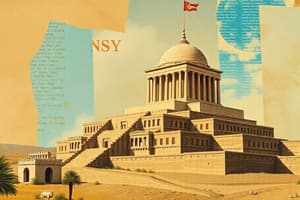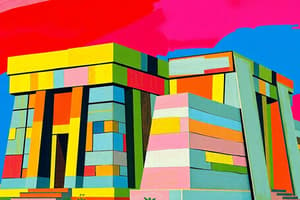Podcast
Questions and Answers
What material were the original tablets of the Epic of Gilgamesh inscribed in?
What material were the original tablets of the Epic of Gilgamesh inscribed in?
- Stone
- Wood
- Clay (correct)
- Papyrus
Which role in Sumerian government was primarily responsible for construction and public works?
Which role in Sumerian government was primarily responsible for construction and public works?
- Priest-King
- Commander
- Patesi
- Hereditary King (correct)
What is the significance of the trading surplus in Sumerian culture?
What is the significance of the trading surplus in Sumerian culture?
- It decreased long-distance trade.
- It isolated Sumer from other cultures.
- It allowed for cultural diffusion. (correct)
- It led to the destruction of city-states.
What was the Sumerian understanding of the afterlife?
What was the Sumerian understanding of the afterlife?
Which of the following best describes the architecture of the city of Ur?
Which of the following best describes the architecture of the city of Ur?
What was the role of priests in Sumerian government during times of peace?
What was the role of priests in Sumerian government during times of peace?
What is a primary characteristic of the White Temple built around 3000 BC?
What is a primary characteristic of the White Temple built around 3000 BC?
What was the dual nature of government in Sumerian city-states?
What was the dual nature of government in Sumerian city-states?
What was a chief building type in ancient Mesopotamian architecture?
What was a chief building type in ancient Mesopotamian architecture?
Which two rivers were significant to the region known as Mesopotamia?
Which two rivers were significant to the region known as Mesopotamia?
Which of the following best describes the political structure of Sumerian city-states?
Which of the following best describes the political structure of Sumerian city-states?
What characteristic is NOT associated with Sumerian architecture?
What characteristic is NOT associated with Sumerian architecture?
What is a fundamental aspect of Sumerian religion?
What is a fundamental aspect of Sumerian religion?
What significant literary work originated from ancient Mesopotamia?
What significant literary work originated from ancient Mesopotamia?
When was the earliest known cuneiform script created?
When was the earliest known cuneiform script created?
Which structure served as an approach to royal palaces in ancient Mesopotamian cities?
Which structure served as an approach to royal palaces in ancient Mesopotamian cities?
Flashcards are hidden until you start studying
Study Notes
Ancient Near East (Mesopotamia)
- Mesopotamia is located in Southwest Asia, encompassing modern-day Iraq and Syria.
- It's referred to as the "Fertile Crescent" due to its curved shape and rich agricultural land.
- The region derives its name from its position "between the rivers" - the Tigris and Euphrates.
Mesopotamian Architectural Characteristics
- Mesopotamian architecture is known for its arcuated style.
- Cities were elevated on vast platforms constructed from bricks and clay.
- Roofs were flat, supported by arches or domes.
- Palaces featured a stepped battlement outline and were accessed through two colossal human-headed winged bull statues.
- Walls were adorned with glazed bricks and decorated with hieroglyphics.
- The ziggurat was the primary building type.
Sumerian Civilization
- Sumerian civilization emerged as city-states, with the first settlements appearing around 3300 BC.
- Initially, priests held the reins of power, but warriors eventually transitioned into kings.
- Sumerian society was ruled by dynasties, which are continuous lines of rulers from the same family.
Sumerian Cuneiform
- Cuneiform is a system of writing developed by the Sumerians, using wedge-shaped marks pressed into clay tablets.
- The script evolved over time, progressing through several stages of development.
Sumerian Religion
- Sumerians adhered to polytheism, believing in multiple gods with human-like qualities.
- Their deities displayed both strength and weakness, and they were often seen as unpredictable and cruel towards humans.
- Mesopotamian religion lacked a sense of ethical principles.
The Epic of Gilgamesh
- The Epic of Gilgamesh is a famous Sumerian tale about a powerful king who embarks on a quest for eternal life.
- Composed over 4,000 years ago, it's considered the oldest known piece of literature.
- Originally inscribed on clay tablets, the epic has been discovered and preserved throughout history.
- The story is told across 12 tablets, with the first 11 focusing on Gilgamesh's life and the final tablet depicting his journey to the netherworld.
Sumerian Government
- Sumerian city-states had dual governments:
- Monarchies led by hereditary kings.
- Theocracies led by priest-kings known as Patesi.
- The absence of a central government left Sumer vulnerable to external invasions.
Sumerian Religion
- Religion played a central role in Sumerian life.
- Sumerians believed in a multitude of gods.
- Their deities were perceived as selfish and prone to anger, inflicting punishments like floods and famine.
- Sumerian beliefs depicted the afterlife as a bleak and desolate realm devoid of light and air.
Duties of a Sumerian King
- Sumerian kings bore the responsibility of:
- Leading and training armies.
- Overseeing the construction and maintenance of public works, such as irrigation canals, water supplies, and storage facilities.
Government of Sumer
- Early Sumerian governments were controlled by temple priests.
- The ziggurat served as the city hall, from where priests managed the city's essential industries.
- Sumerian people were taxed.
- During times of war, a military commander, chosen by the people, superseded the priests' authority.
- After 3000 BC, military commanders retained power, effectively becoming kings, alongside the priests.
Cultural Interaction, Economics, and Empire Building
- Sumerian surplus production allowed them to engage in long-distance trade and establish new city-states.
- The exchange of goods and ideas led to cultural diffusion, spreading knowledge and innovation across different cultures.
- The consolidation of diverse nations under a single ruler resulted in the formation of empires.
Sumerian Architecture
- Sumerian cities were enclosed by walls, with ziggurat temples and palaces serving as their focal points.
- Residential, commercial, and industrial structures formed the city's fabric.
The White Temple of Uruk
- Uruk, a major Sumerian city by 3300 BC, housed approximately 40,000 inhabitants and spanned 2 square kilometers.
- The White Temple, situated on a ziggurat, stood 12 meters above ground and was constructed around 3000 BC.
- The ziggurat and temple were built using mud bricks, and the temple had a rectangular shape.
Studying That Suits You
Use AI to generate personalized quizzes and flashcards to suit your learning preferences.




